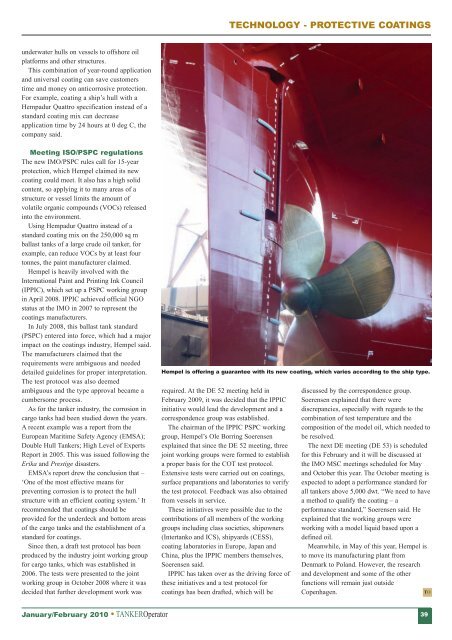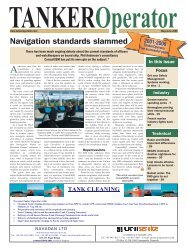Download - Tanker Operator
Download - Tanker Operator
Download - Tanker Operator
You also want an ePaper? Increase the reach of your titles
YUMPU automatically turns print PDFs into web optimized ePapers that Google loves.
TECHNOLOGY - PROTECTIVE COATINGS<br />
underwater hulls on vessels to offshore oil<br />
platforms and other structures.<br />
This combination of year-round application<br />
and universal coating can save customers<br />
time and money on anticorrosive protection.<br />
For example, coating a ship’s hull with a<br />
Hempadur Quattro specification instead of a<br />
standard coating mix can decrease<br />
application time by 24 hours at 0 deg C, the<br />
company said.<br />
Meeting ISO/PSPC regulations<br />
The new IMO/PSPC rules call for 15-year<br />
protection, which Hempel claimed its new<br />
coating could meet. It also has a high solid<br />
content, so applying it to many areas of a<br />
structure or vessel limits the amount of<br />
volatile organic compounds (VOCs) released<br />
into the environment.<br />
Using Hempadur Quattro instead of a<br />
standard coating mix on the 250,000 sq m<br />
ballast tanks of a large crude oil tanker, for<br />
example, can reduce VOCs by at least four<br />
tonnes, the paint manufacturer claimed.<br />
Hempel is heavily involved with the<br />
International Paint and Printing Ink Council<br />
(IPPIC), which set up a PSPC working group<br />
in April 2008. IPPIC achieved official NGO<br />
status at the IMO in 2007 to represent the<br />
coatings manufacturers.<br />
In July 2008, this ballast tank standard<br />
(PSPC) entered into force, which had a major<br />
impact on the coatings industry, Hempel said.<br />
The manufacturers claimed that the<br />
requirements were ambiguous and needed<br />
detailed guidelines for proper interpretation.<br />
The test protocol was also deemed<br />
ambiguous and the type approval became a<br />
cumbersome process.<br />
As for the tanker industry, the corrosion in<br />
cargo tanks had been studied down the years.<br />
A recent example was a report from the<br />
European Maritime Safety Agency (EMSA);<br />
Double Hull <strong>Tanker</strong>s; High Level of Experts<br />
Report in 2005. This was issued following the<br />
Erika and Prestige disasters.<br />
EMSA’s report drew the conclusion that –<br />
‘One of the most effective means for<br />
preventing corrosion is to protect the hull<br />
structure with an efficient coating system.’ It<br />
recommended that coatings should be<br />
provided for the underdeck and bottom areas<br />
of the cargo tanks and the establishment of a<br />
standard for coatings.<br />
Since then, a draft test protocol has been<br />
produced by the industry joint working group<br />
for cargo tanks, which was established in<br />
2006. The tests were presented to the joint<br />
working group in October 2008 where it was<br />
decided that further development work was<br />
Hempel is offering a guarantee with its new coating, which varies according to the ship type.<br />
required. At the DE 52 meeting held in<br />
February 2009, it was decided that the IPPIC<br />
initiative would lead the development and a<br />
correspondence group was established.<br />
The chairman of the IPPIC PSPC working<br />
group, Hempel’s Ole Borring Soerensen<br />
explained that since the DE 52 meeting, three<br />
joint working groups were formed to establish<br />
a proper basis for the COT test protocol.<br />
Extensive tests were carried out on coatings,<br />
surface preparations and laboratories to verify<br />
the test protocol. Feedback was also obtained<br />
from vessels in service.<br />
These initiatives were possible due to the<br />
contributions of all members of the working<br />
groups including class societies, shipowners<br />
(Intertanko and ICS), shipyards (CESS),<br />
coating laboratories in Europe, Japan and<br />
China, plus the IPPIC members themselves,<br />
Soerensen said.<br />
IPPIC has taken over as the driving force of<br />
these initiatives and a test protocol for<br />
coatings has been drafted, which will be<br />
discussed by the correspondence group.<br />
Soerensen explained that there were<br />
discrepancies, especially with regards to the<br />
combination of test temperature and the<br />
composition of the model oil, which needed to<br />
be resolved.<br />
The next DE meeting (DE 53) is scheduled<br />
for this February and it will be discussed at<br />
the IMO MSC meetings scheduled for May<br />
and October this year. The October meeting is<br />
expected to adopt a performance standard for<br />
all tankers above 5,000 dwt. “We need to have<br />
a method to qualify the coating – a<br />
performance standard,” Soerensen said. He<br />
explained that the working groups were<br />
working with a model liquid based upon a<br />
defined oil.<br />
Meanwhile, in May of this year, Hempel is<br />
to move its manufacturing plant from<br />
Denmark to Poland. However, the research<br />
and development and some of the other<br />
functions will remain just outside<br />
Copenhagen.<br />
TO<br />
January/February 2010 TANKER<strong>Operator</strong> 39

















